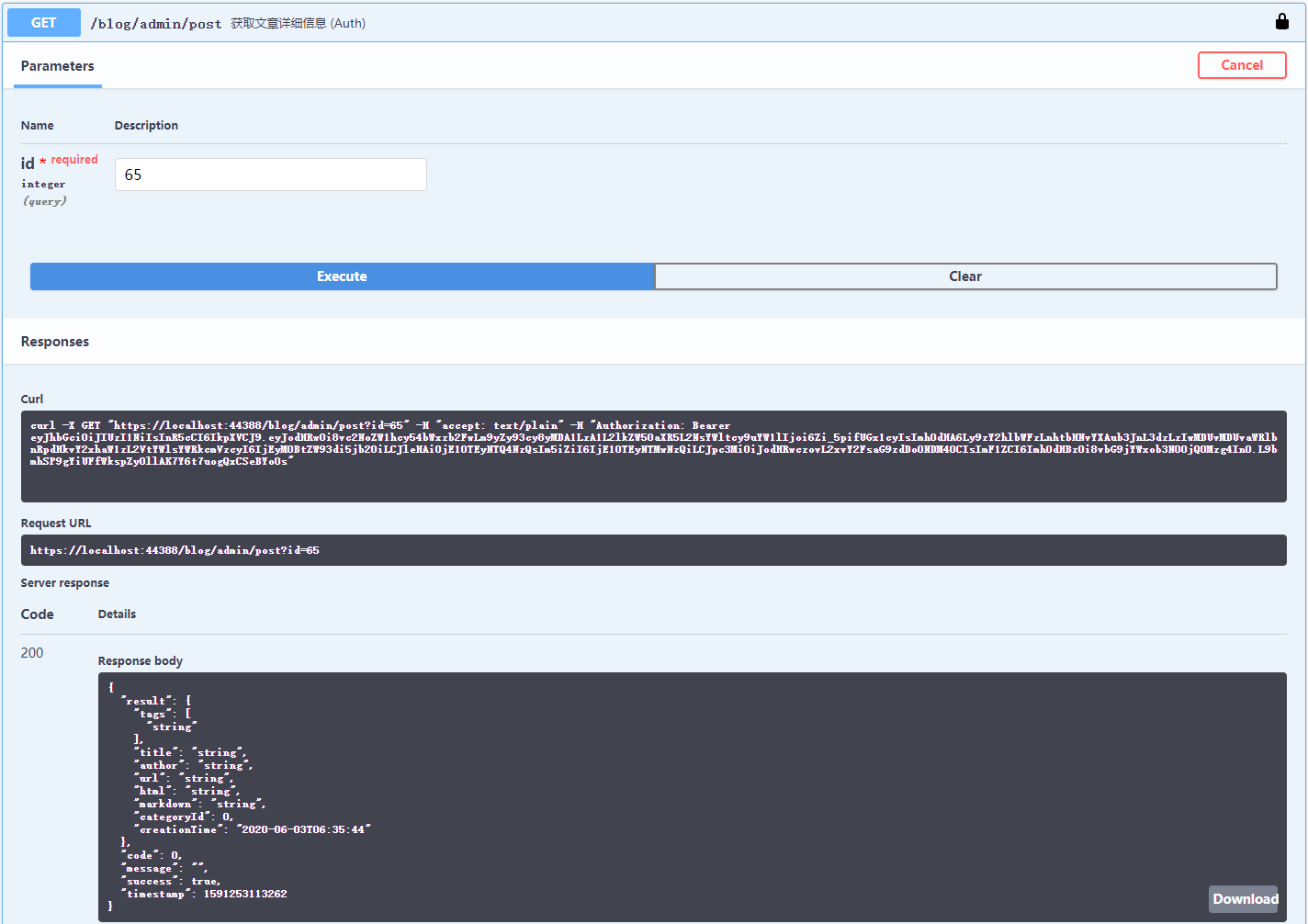# 博客接口实战篇(四)
上篇文章完成了文章增删改的接口和友情链接列表的接口,本篇继续。
善于思考的同学肯定发现,在执行增删改操作后,Redis缓存中的数据还是存在的,也就意味着查询接口返回的数据还是旧的,所以在写接口之前,先完成一下清缓存的操作。
# 移除缓存
移除缓存我这里找了一个新的包:Caching.CSRedis,选他是因为微软的包Microsoft.Extensions.Caching.StackExchangeRedis没有给我们实现批量删除的功能。
Caching.CSRedis开源地址,https://github.com/2881099/csredis (opens new window) 在这不做过多介绍,感兴趣的自己去看。
在.Application.Caching层添加包Caching.CSRedis,Install-Package Caching.CSRedis,然后在模块类MeowvBlogApplicationCachingModule中进行配置。
//MeowvBlogApplicationCachingModule.cs
...
public override void ConfigureServices(ServiceConfigurationContext context)
{
...
var csredis = new CSRedis.CSRedisClient(AppSettings.Caching.RedisConnectionString);
RedisHelper.Initialization(csredis);
context.Services.AddSingleton<IDistributedCache>(new CSRedisCache(RedisHelper.Instance));
}
...
2
3
4
5
6
7
8
9
10
11
12
直接新建一个移除缓存的接口:ICacheRemoveService,添加移除缓存的方法RemoveAsync()。代码较少,可以直接写在缓存基类CachingServiceBase中。
public interface ICacheRemoveService
{
/// <summary>
/// 移除缓存
/// </summary>
/// <param name="key"></param>
/// <param name="cursor"></param>
/// <returns></returns>
Task RemoveAsync(string key, int cursor = 0);
}
2
3
4
5
6
7
8
9
10
然后可以在基类中实现这个接口。
public async Task RemoveAsync(string key, int cursor = 0)
{
var scan = await RedisHelper.ScanAsync(cursor);
var keys = scan.Items;
if (keys.Any() && key.IsNotNullOrEmpty())
{
keys = keys.Where(x => x.StartsWith(key)).ToArray();
await RedisHelper.DelAsync(keys);
}
}
2
3
4
5
6
7
8
9
10
11
12
简单说一下这个操作过程,使用ScanAsync()获取到所有的Redis key值,返回的是一个string数组,然后根据参数找到符合此前缀的所有key,最后调用DelAsync(keys)删除缓存。
在需要有移除缓存功能的接口上继承ICacheRemoveService,这里就是IBlogCacheService。
//IBlogCacheService.cs
namespace Meowv.Blog.Application.Caching.Blog
{
public partial interface IBlogCacheService : ICacheRemoveService
{
}
}
2
3
4
5
6
7
在基类中已经实现了这个接口,所以现在所有继承基类的缓存实现类都可以调用移除缓存方法了。
在MeowvBlogConsts中添加缓存前缀的常量。
//MeowvBlogConsts.cs
/// <summary>
/// 缓存前缀
/// </summary>
public static class CachePrefix
{
public const string Authorize = "Authorize";
public const string Blog = "Blog";
public const string Blog_Post = Blog + ":Post";
public const string Blog_Tag = Blog + ":Tag";
public const string Blog_Category = Blog + ":Category";
public const string Blog_FriendLink = Blog + ":FriendLink";
}
2
3
4
5
6
7
8
9
10
11
12
13
14
15
16
17
18
然后在BlogService.Admin.cs服务执行增删改后调用移除缓存的方法。
//BlogService.Admin.cs
// 执行清除缓存操作
await _blogCacheService.RemoveAsync(CachePrefix.Blog_Post);
2
3
4
因为是小项目,采用这种策略直接删除缓存,这样就搞定了当在执行增删改操作后,前台接口可以实时查询出最后的结果。
# 文章详情

当我们修改文章数据的时候,是需要把当前数据库中的数据带出来显示在界面上的,因为有可能只是个别地方需要修改,所以这还需要一个查询文章详情的接口,当然这里的详情和前端的是不一样的,这里是需要根据Id主键去查询。
添加模型类PostForAdminDto.cs,直接继承PostDto,然后添加一个Tags列表就行,==,好像和上一篇文章中的EditPostInput字段是一模一样的。顺手将EditPostInput改一下吧,具体代码如下:
//PostForAdminDto.cs
using System.Collections.Generic;
namespace Meowv.Blog.Application.Contracts.Blog
{
public class PostForAdminDto : PostDto
{
/// <summary>
/// 标签列表
/// </summary>
public IEnumerable<string> Tags { get; set; }
}
}
//EditPostInput.cs
namespace Meowv.Blog.Application.Contracts.Blog.Params
{
public class EditPostInput : PostForAdminDto
{
}
}
2
3
4
5
6
7
8
9
10
11
12
13
14
15
16
17
18
19
20
21
在IBlogService.Admin.cs中添加接口。
/// <summary>
/// 获取文章详情
/// </summary>
/// <param name="id"></param>
/// <returns></returns>
Task<ServiceResult<PostForAdminDto>> GetPostForAdminAsync(int id);
2
3
4
5
6
实现这个接口。
/// <summary>
/// 获取文章详情
/// </summary>
/// <param name="id"></param>
/// <returns></returns>
public async Task<ServiceResult<PostForAdminDto>> GetPostForAdminAsync(int id)
{
var result = new ServiceResult<PostForAdminDto>();
var post = await _postRepository.GetAsync(id);
var tags = from post_tags in await _postTagRepository.GetListAsync()
join tag in await _tagRepository.GetListAsync()
on post_tags.TagId equals tag.Id
where post_tags.PostId.Equals(post.Id)
select tag.TagName;
var detail = ObjectMapper.Map<Post, PostForAdminDto>(post);
detail.Tags = tags;
detail.Url = post.Url.Split("/").Where(x => !string.IsNullOrEmpty(x)).Last();
result.IsSuccess(detail);
return result;
}
2
3
4
5
6
7
8
9
10
11
12
13
14
15
16
17
18
19
20
21
22
23
24
先根据Id查出文章数据,再通过联合查询找出标签数据。
CreateMap<Post, PostForAdminDto>().ForMember(x => x.Tags, opt => opt.Ignore());
新建一条AutoMapper配置,将Post转换成PostForAdminDto,忽略Tags。
然后将查出来的标签、Url赋值给DTO,输出即可。在BlogController.Admin中添加API。
/// <summary>
/// 获取文章详情
/// </summary>
/// <param name="id"></param>
/// <returns></returns>
[HttpGet]
[Authorize]
[Route("admin/post")]
[ApiExplorerSettings(GroupName = Grouping.GroupName_v2)]
public async Task<ServiceResult<PostForAdminDto>> GetPostForAdminAsync([Required] int id)
{
return await _blogService.GetPostForAdminAsync(id);
}
2
3
4
5
6
7
8
9
10
11
12
13

至此,完成了关于文章的所有接口。
接下来按照以上方式依次完成分类、标签、友链的增删改查接口,我觉得如果你有跟着我一起做,剩下的可以自己完成。
← 博客接口实战篇(三) 博客接口实战篇(五) →